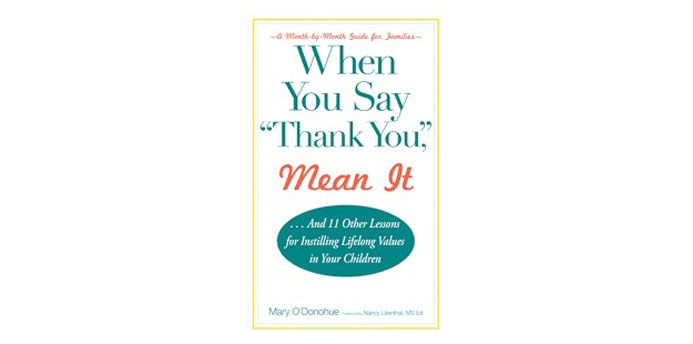Mary O’Donohue’s “aha” moment occurred not during her work hours as an editing supervisor at the Oprah Show, but at home, when her then 5-year-old son received a birthday gift.
The blue shirt, carefully chosen for him by a family friend, received not more than a cursory glance from her son before it was discarded and abandoned.
“I realized that when my husband and I prompted these `thank you’s’ from our son, we were prompting him to act thankful rather than be a grateful person,” says O’Donohue, who lives in west suburban Westchester.
From that little wake-up call—one which might resonate with many parents—came the idea for “When You Say `Thank You,’ Mean It,” a parenting book that features one value per month, and a myriad of fun ways for your family to learn it together.
The year begins with gratitude month, with ideas ranging from making a gratitude board (a poster where each member of the family lists one thing they are thankful for each day) to the “thanks for nothin’” letter, which is a thank you to anyone—a teacher, relative, friend—simply for being who they are. An exercise called “rewind” prompts you to think about questions such as `where did your dinner come from?’
During December (otherwise known as `A Sense of Purpose’ month), a “Getting to Know Me” question-and-answer session yielded results that even surprised Donohue.
“My question of the day was `please describe your perfect school.’ My daughter said her perfect school would have music, drawing and painting. I had no idea she was interested in the arts!” O’Donohue laughs. “We encouraged her, and she blossomed. She sat down at the piano. She started painting. My children love sharing things about themselves and teaching me about them.”
As it turns out, the lessons are not only for the children. One day, O’Donohue wanted to borrow a book that was in her daughter’s bedroom. Although the temptation to just walk in and take the book was great, she waited until her daughter got home from school and then asked permission to borrow it.
O’Donohue credits the book’s methods with helping her family bond through life’s ups and downs— whether she was super hectic during the last few years of the Oprah Show, or going through the stress of navigating the “what happens after Oprah” months.
“We treat each other with even more respect,” she says. “Living the values with my family and not taking them for granted has brought us closer. It’s made us as grown-ups much more three-dimensional to our kids as people. It lets them get to know us and shows them that hey, these values aren’t new—we’ve been living them our whole lives.”

